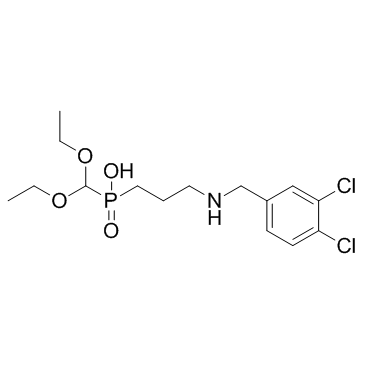GABA(B) presynaptic receptors modulate glycine exocytosis from mouse spinal cord and hippocampus glycinergic nerve endings.
Cristina Romei, Elisa Luccini, Maurizio Raiteri, Luca Raiteri
文献索引:Pharmacol. Res. 59(3) , 154-9, (2009)
全文:HTML全文
摘要
Glycine release and modulation of glycine exocytosis by presynaptic receptors have been rarely studied. We here investigate on the existence and the pharmacological profile of GABA(B) receptors regulating glycine release in mouse spinal cord and hippocampus. Synaptosomes were preincubated with [(3)H]glycine in presence of the glycine transporter 1 inhibitor NFPS, in order to study release from glycinergic terminals selectively labelled through the glycine transporter 2, and depolarized in superfusion with concentrations of KCl (12 and 15 mM) previously found to elicit exocytosis of glycine. Exposure of synaptosomes to (-)-baclofen caused inhibition of [(3)H]glycine overflow: EC(50)=0.62+/-0.08 microM, E(max) approximately 65% in the spinal cord and EC(50)=0.58+/-0.07 microM, E(max) approximately 55% in the hippocampus. The effect of 3 microM (-)-baclofen in the spinal cord was prevented by the GABA(B) receptor antagonists CGP 52432 (IC(50)=22.6+/-2.15 microM) and CGP 35348 (IC(50)=5.99+/-1.21 microM), whereas phaclofen was ineffective. In the hippocampus, the CGP antagonists were more potent than in the spinal cord, their IC(50) values amounting to 0.81+/-0.08 microM and to 0.94+/-0.09 microM, respectively; phaclofen (100-300 microM) was a weak antagonist. It is concluded that: (i) glycinergic nerve terminals in spinal cord and hippocampus possess GABA(B) receptors mediating inhibition of the evoked glycine exocytosis; (ii) the pharmacological profiles of the receptors are qualitatively similar in the two regions; (iii) low concentrations of GABA(B) antagonists appear able to preferentially inhibit the receptors located on hippocampal glycinergic nerve endings.
相关化合物
| 结构式 | 名称/CAS号 | 分子式 | 全部文献 |
|---|---|---|---|
 |
4-苄氧基苯基异硫氰酸酯
CAS:139667-74-6 |
C15H24Cl2NO4P |
|
Correlated changes in NMDA receptor phosphorylation, functio...
2010-12-01 [J. Neurochem. 115(5) , 1112-22, (2010)] |
|
Presynaptic mGlu7 receptors control GABA release in mouse hi...
2013-03-01 [Neuropharmacology 66 , 215-24, (2013)] |
|
Hippocampal Pyramidal Neurons Comprise Two Distinct Cell Typ...
2012-11-21 [Neuron 76(4) , 776-89, (2012)] |
|
Activation of GABA-B receptors induced by systemic amphetami...
2010-09-01 [J. Neurochem. 114(6) , 1678-86, (2010)] |
|
Alteration of GABAergic neurotransmission by pulsed infrared...
2010-09-30 [J. Neurosci. Methods 192(1) , 110-4, (2010)] |